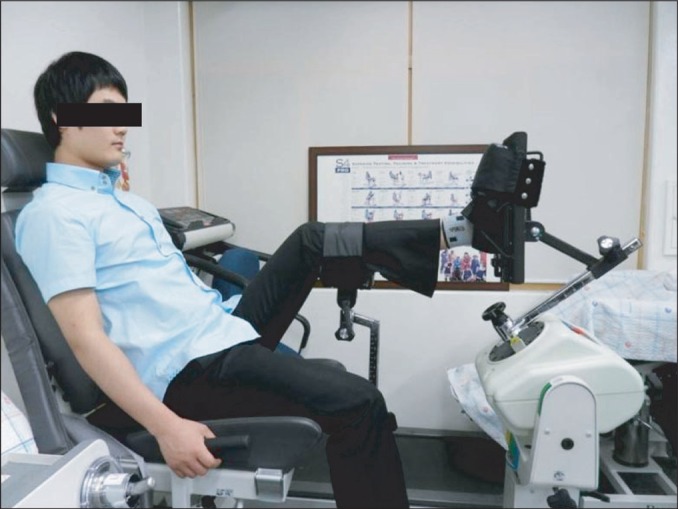Ann Rehabil Med.
2013 Feb;37(1):10-16. 10.5535/arm.2013.37.1.10.
The Effects of Changes of Ankle Strength and Range of Motion According to Aging on Balance
- Affiliations
-
- 1Department of Rehabilitation Medicine, Chungnam National University School of Medicine, Daejeon, Korea. drlovingss@gmail.com
- KMID: 2266645
- DOI: http://doi.org/10.5535/arm.2013.37.1.10
Abstract
OBJECTIVE
To investigate the changes of ankle strength and range of motion with aging and which of the ankle strength and range of motion are contributed to balance.
METHODS
Sixty healthy people (24 men and 36 women) have undergone tests for ankle strength and range of motion, using Biodex System 4 Pro; a one-leg balance, including postural sway and stability index using a Balance System; in which data were collected in a self-reported Desmond fall risk questionnaire.
RESULTS
Participants are classified into 3 groups by age (group 1, 20-40 years; group 2, 40-65 years; group 3, over 65 years). Stability index and postural sway is significantly increased with aging. Ankle plantarflexor strength and ankle eversion range of motion is significantly decreased with aging. Pearson's correlation revealed that ankle plantarflexor strength is significantly correlated with anterior/posterior sway, and ankle eversion range of motion is significantly correlated with medial/lateral sway in the aged group (over 65 years).
CONCLUSION
Stability, ankle plantarflexor strength, and eversion range of motion is declined with aging. In addition, strength of ankle plantarflexor and eversion range of motion is significantly correlated with balance stability. Further studies are needed for programs to improve the strength of plantarflexor, and range of motion of eversion of the ankle are beneficial in improving balance, stability, and prevention of falling in the elderly.
Keyword
Figure
Cited by 1 articles
-
Vitamin D Status according to the Diseases in Hospitalized Rehabilitation Patients: Single Center Study
Hanbit Ko, Jin Hee Nam, Soo-kyung Bok
Brain Neurorehabil. 2019;12(1):. doi: 10.12786/bn.2019.12.e5.
Reference
-
1. Tinetti ME, Speechley M, Ginter SF. Risk factors for falls among elderly persons living in the community. N Engl J Med. 1988; 319:1701–1707. PMID: 3205267.
Article2. Campbell AJ, Borrie MJ, Spears GF. Risk factors for falls in a community-based prospective study of people 70 years and older. J Gerontol. 1989; 44:M112–M117. PMID: 2738307.
Article3. Brody LT. Hall CM, Brody LT, editors. Balance impairment. Therapeutic exercise: moving toward function. 1999. Philadelphia: Lippincott Williams & Wilkins;p. 112–127.4. Nashner LM. Duncan PW, editor. Sensory neuromuscular and biomechanical contributions to human balance. Balance: proceedings of the APTA Forum. 1990. 1989 Jun 13-15; Nashville, TN. Alexandria, VA: American Physical Therapy Association.5. Lord SR, Clark RD, Webster IW. Postural stability and associated physiological factors in a population of aged persons. J Gerontol. 1991; 46:M69–M76. PMID: 2030269.
Article6. Daubney ME, Culham EG. Lower-extremity muscle force and balance performance in adults aged 65 years and older. Phys Ther. 1999; 79:1177–1185. PMID: 10630286.
Article7. Colledge NR, Cantley P, Peaston I, Brash H, Lewis S, Wilson JA. Ageing and balance: the measurement of spontaneous sway by posturography. Gerontology. 1994; 40:273–278. PMID: 7959084.
Article8. Grimston SK, Nigg BM, Hanley DA, Engsberg JR. Differences in ankle joint complex range of motion as a function of age. Foot Ankle. 1993; 14:215–222. PMID: 8359768.
Article9. Bennell KL, Goldie PA. The differential effects of external ankle support on postural control. J Orthop Sports Phys Ther. 1994; 20:287–295. PMID: 7849748.
Article10. Vandervoort AA, Chesworth BM, Cunningham DA, Paterson DH, Rechnitzer PA, Koval JJ. Age and sex effects on mobility of the human ankle. J Gerontol. 1992; 47:M17–M21. PMID: 1730848.
Article11. Woo YK, Hwang JH, An J, Park H, Kim YH, Lee PK, et al. Effect of characteristics of joint motion of lower extremity according to aging on balance in elderly. J Korean Acad Rehabil Med. 2005; 29:109–118.12. Laughton CA, Slavin M, Katdare K, Nolan L, Bean JF, Kerrigan DC, et al. Aging, muscle activity, and balance control: physiologic changes associated with balance impairment. Gait Posture. 2003; 18:101–108. PMID: 14654213.
Article13. Lim KB, Na YM, Lee HJ, Joo SJ. Comparison of postural control measures between older and younger adults using balance master system. J Korean Acad Rehabil Med. 2003; 27:418–423.14. Whipple RH, Wolfson LI, Amerman PM. The relationship of knee and ankle weakness to falls in nursing home residents: an isokinetic study. J Am Geriatr Soc. 1987; 35:13–20. PMID: 3794141.
Article15. Macrae PG, Lacourse M, Moldavon R. Physical performance measures that predict faller status in community-dwelling older adults. J Orthop Sports Phys Ther. 1992; 16:123–128. PMID: 18796765.
Article16. Spink MJ, Fotoohabadi MR, Wee E, Hill KD, Lord SR, Menz HB. Foot and ankle strength, range of motion, posture, and deformity are associated with balance and functional ability in older adults. Arch Phys Med Rehabil. 2011; 92:68–75. PMID: 21187207.
Article17. Amundsen LR. Kauffman TL, editor. Effects of age on joints and ligaments. Geriatric rehabilitation manual. 1999. New York: Churchill Livingstone;p. 14–16.
Article
- Full Text Links
- Actions
-
Cited
- CITED
-
- Close
- Share
- Similar articles
-
- Relationships among Lower Extremity Muscle Circumference, Proprioception, ROM, Muscle Strength, and Balance Control Ability in Young Adults
- Effect of Characteristics of Joint Motion of Lower Extremity according to Aging on Balance in Elderly
- Comparison of Foot Structure, Function, Plantar Pressure and Balance Ability According to the Body Mass Index of Young Adults
- Effects of Extracorporeal Shock Wave Therapy on Ankle Function, Range of Motion, and Dynamic Balance in Patients with Chronic Ankle Instability
- Is Ankle Kinesio Taping Effective to Immediately Change Balance, Range of Motion, and Muscle Strength in Healthy Individuals? A Randomized, Sham-Controlled Trial



